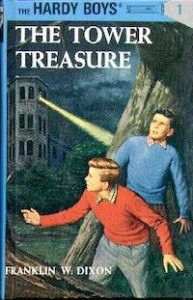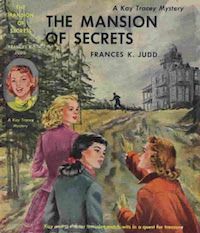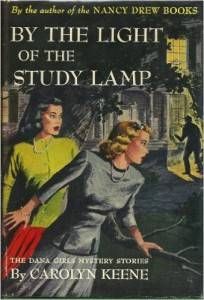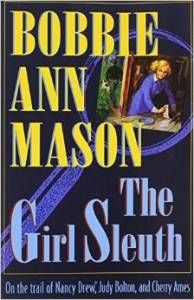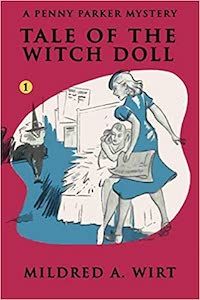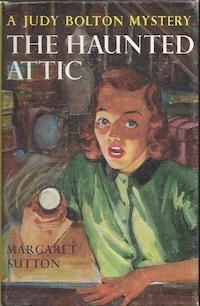
Nancy Drew Wasn’t the Only Girl Detective: Learn About 8 Other Classic Teen Sleuths
We’ve talked a lot about Nancy Drew here at Book Riot. We’ve ranked all 56 of the original books. We’ve told you about our favorite covers. And because it’s the plucky teen sleuth’s 90th birthday this year, we’ve even got some ideas for how to celebrate.
Though we’ve met many more teen detectives since Nancy debuted in 1930—from the Scooby Gang to Veronica Mars—when the first Nancy book, The Secret of the Old Clock, appeared, girl sleuths were not the norm in children’s literature. (No one thought 16-year-olds could solve serious crimes? Shocking, I know!) But that was about to change. The popularity of Nancy Drew and the Hardy Boys, both created by kid lit mastermind Edward Stratemeyer, proved that kids wanted to read about other kids catching jewel thieves. And Stratemeyer and other publishers continued the trend throughout the 1930s, ’40s, and ’50s, creating an Avengers-like stable of cheerful teen detectives.
So Nancy wasn’t the only well-coiffed teen girl finding missing people and fortunes, but she was by far the most popular one, with sales of over 70 million Nancy Drew Mystery Stories books since the 1930s. Many of her contemporaries are now out of print or only dimly remembered, which is a shame because they each brought something different to the kid lit pantheon (a nurse detective, for example). In honour of 90 years of Nancy, I’ve created a rundown of the other books like Nancy Drew from that era of children’s publishing.
Note: This list of other teen sleuths is incredibly white. In most cases, even the main character’s circle of friends and acquaintances is completely white—perhaps not unexpected for the publishing industry in the 1930s and ’40s, but still disappointing. This Book Riot post has some suggestions for more ethnically diverse Nancy Drew read-alikes. And here’s a list of modern mysteries by authors of color and/or LGBTQ+ authors!
Versions “For Boys”: The Hardy Boys
Nancy was not the first teen detective. The concept we know and love was born when Edward Stratemeyer came up with the exciting new idea of teen brothers solving crimes. Frank and Joe Hardy are 18 and 16, respectively, and live with their parents and aunt in the town of Bayport. As in many of these teen sleuth series, Frank and Joe have a familial connection to crime—in this case their father, Fenton, is a detective. They do technically go to school, but it never gets in the way of solving thefts, diamond smugglings, horse kidnappings (?) and other crimes that were apparently rife in small-town America.
The brothers made their first mystery-solving appearance in 1927’s The Tower Treasure. In 1959, the earliest books in the series were revised to remove some racist language and characterization, to streamline the language, and to make plots more fast-paced and exciting. If you’ve read a Hardy Boys book, you’ve probably read one of the post-1959 versions. In 1979, the original series officially ceased publication after The Sting of the Scorpion, but Frank and Joe have lived on in numerous spin-off series, TV shows, and comics. (And a new TV show coming soon.)
The Hardy Boys books share many similarities with Nancy Drew, from writing style to cover art, because Stratemeyer first perfected something called book packaging on Frank and Joe. He outlined the plot of each book himself before passing it along to a ghostwriter, who would write the story. The series was sold to publishing company Grosset & Dunlap, who gave them a fake author, Franklin W. Dixon. When Stratemeyer saw how successful the Hardy Boys were, he decided to create a version “for girls.” Exactly the same outlining and ghostwriting process was used to create Nancy Drew books and many of the other books on this list. And the Nancy books were also revised and republished in the early 1960s. This Book Riot post breaks down how that worked in more detail.
Basically Nancy, But Less Fun: Kay Tracey
Kay Tracey was yet another Stratemeyer creation who followed fast on the heels of Frank, Joe, and Nancy. A high school student living with her mother and cousin (a lawyer like Carson Drew), Kay debuted in 1934 and starred in 18 adventures. This series never took off despite its similarities to the much more popular Nancy books. Critics felt Kay was not as logical and methodical as Nancy and that she didn’t enjoy the same level of power and autonomy that Nancy did. Unlike Nancy, Kay did not have a car and had to attend school. Nancy’s ability to hold sway over the police chief, her father, and various other male authority figures was a key part of her appeal for budding young feminist readers, who may not have found that same sense of independence in the Kay books.
Boarding School Sleuths: The Dana Girls
Also debuting in 1934, this series took the Nancy Drew formula, added a sister, and moved the mysteries to the exciting locale of a boarding school. Orphaned sisters Jean and Louisa Dana attend the Starhurst School for Girls, where they investigate such crimes as can be found on a school campus. You’ll see from the cover image that this series, also published by Grosset & Dunlap, was “written by” Carolyn Keene (remember, it was just a pseudonym for a group of ghostwriters), but these books have some key differences from Nancy Drew. All the action revolves around school, while Nancy was out of school and free to engage in all kinds of activities. The girls’ headmistress also gets involved in some of their sleuthing, so they partner with an established authority figure far more often than Nancy does. And finally, the very fact that they’re sisters sets them apart from Nancy, who is an only child, often investigates by herself, and is beholden to almost no one. A melding of the teen sleuth and boarding school genres seems like a no-brainer, but this series never quite took off in pop culture, even though it lasted until 1979.
Solving Crimes in the Countryside: Trixie Belden
If you’ve read any series other than Nancy Drew or the Hardy Boys from this list, it might be this one. The Trixie Belden books enjoyed a good deal of popularity. Trixie didn’t appear in print until 1948, but she won over readers with her girl next door appeal and humble country upbringing. Trixie lives on an idyllic farm with a happy family. She’s also younger than the other girl detectives on this list—only 13 at the beginning of the series. Her adventures have a homier, cozier feel. Trixie also has brothers and friends with whom she forms a mystery-solving club, lending these books more of an ensemble sleuthing feel. (Nancy, in contrast, is always the star of the show.) The series was created by Julie Campbell, who wrote the first six books herself, no doubt helping to firmly establish the feel of the series before ghostwriters took over.
The Crime-Solving Nurse: Cherry Ames
Yes, a crime-solving nurse! Hard to imagine a nurse would have time to solve mysteries, but Cherry did it all. The first book was published in 1943 and that helps to explain Cherry’s nursing background: it was a way to encourage girls to become nurses or otherwise help the war effort. The first few books cover Cherry’s training and experience during the war, but eventually she begins traveling to a variety of places where, apparently, both a nurse and a detective were needed. From dude ranch to cruise to department store, Cherry can nurse anyone and solve any crime.
The Career Girl: Connie Blair
Connie Blair starred in a series of 12 mysteries from 1948 to 1958. Connie is an unusual teen sleuth because she works—first as a model, then as a secretary who works her way up in the world of advertising. Set in Philadelphia, this series was criticized for sexism. Critic and writer Bobbie Ann Mason, author of The Girl Sleuth, points out that Connie uses feminine wiles to get her way or aid her in her investigations. However, Connie’s status as an independent career woman is pretty unusual in the teen detective genre.
The High School Reporter: Penny Parker
Penny Parker was a high school student who both solved mysteries and moonlighted at her father’s newspaper. She was created by Mildred Wirt Benson, one of the original Nancy Drew ghostwriters, who had also been a newspaper reporter. Penny appeared on the scene in 1939 and shared some similarities with Nancy. Her mother was dead, she was involved in her father’s career, and she had a beloved housekeeper who had helped raise her. Plus, like the Nancy and Hardy Boys books, the first four Penny Parker books were revised and republished in the late 1950s. The series wasn’t as popular as Nancy Drew, of course, but digital editions were recently published by Halcyon Press. Start with Tale of the Witch Doll.
Nancy, But Make It Realistic: Judy Bolton
Judy Bolton appeared in 1932, yet another character from Grosset & Dunlap meant to capitalize on the popularity of Nancy and the Hardys. The first novel, The Vanishing Shadow, isn’t much like the rest of the series, so you could start with the far more enjoyable The Haunted Attic and continue from there. In book two, Judy is a newcomer to a bigger city, where she and her family have moved because of her father’s new medical practice. She’s torn between her wealthy city friends and the humble friends she met in her rural hometown. Oh, and there’s a creepy attic, a lost cat, two love interests, and an annoying brother—plus a mystery to solve.
The Judy Bolton books have always been my favorite books like Nancy Drew, and that’s because she actually feels like a real person. In fact, the Judy books stand out on this list for a number of reasons. They were all written by one real person, Margaret Sutton, rather than a group of ghostwriters. Judy isn’t as wealthy as many of her crime-solving friends—her father is a doctor, so they’re comfortable, but they live a pretty modest life and she isn’t jetting off to Scotland or New Orleans at a moment’s notice. Judy also actually attends her high school, and most unusual of all, she ages! She graduates school and even gets married. In a genre full of characters stuck in perpetual adolescence, Judy is unique.
Although Judy was relatively popular, the series was cancelled in 1967. The original 38 books have since been republished in paperback, with the 2012 addition of a new book, The Strange Likeness, written by Kate Duvall and Beverly Hatfield based on a long-lost outline by Sutton. Another new Judy book was published in 2018—so we may have more teen sleuth goodness in store for us yet.
And there you have it: there are so many other classic teen sleuths to befriend! Though Nancy was by far the most popular, the many other books like Nancy Drew suggest that readers from the 1930s to today had an appetite for girl detectives of all kinds. If you still want more Nancy Drew, we’ve got lots for you, including a thoughtful essay about how Nancy helped one reader reject toxic masculinity and a quiz to help you discover how well you know Nancy Drew.



